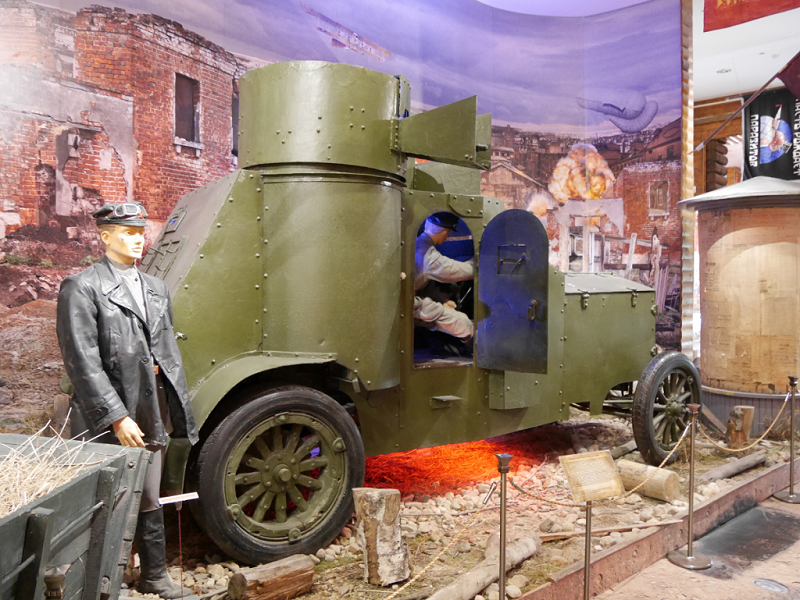Izhorsky Fiat
Fiat-Izhora is a light machine-gun armored vehicle of the Armed Forces of the Russian Empire and the Workers’ and Peasants’ Red Army. Developed on the basis of a car chassis from the Italian company Fiat, produced under license in the USA. Although the development of the project and the purchase of the chassis took place back in 1916, mass production of armored vehicles was launched only after the February Revolution. From 1917 to 1918, about 80 copies of the armored car were built at the Izhora plant. Armored vehicles were actively used by the Red Army in the battles of the Civil War, being the second largest (after “Austins” of various types) in the armored units of the Red Army.
By the end of 1914, there was only one combat unit of armored vehicles in the Russian Imperial Army – the 1st Automobile-Machine-Gun Company, which had mainly Russo-Balt machine-gun armored vehicles. The company’s actions were very successful, but there were complaints about the technical characteristics of the vehicles. As a result, the command of the Russian army was very interested in obtaining more modern combat vehicles. A number of factories and workshops offered various armored car designs. One of them, developed by engineers from the Izhora plant and the Armor department of the Military Automotive School, was considered very promising. However, problems arose in the implementation of the project.
If there were no particular difficulties with the production of armored hulls and weapons, then the chassis for armored cars turned into a real headache for engineers. Very soon it became clear that most Russian cars were practically unsuitable for this purpose, and their production was small-scale. As a result, at the beginning of 1916 it was decided to order suitable chassis abroad and armor them in Russia. The work was also significantly stimulated by the plans of the State Technical University for 1917, which provided for a significant increase in the fleet of armored vehicles: by July 1, 1917, it was planned to have armored cars for 70 machine-gun platoons and a 100% reserve to make up for combat losses, that is, 380 machine-gun and 180 cannon armored cars. The implementation of such Napoleonic plans was possible only if the chassis was purchased abroad.
Cars from the Italian company FIAT, produced under license in the USA, were considered one of the most acceptable. On February 21, 1916, the Anglo-Russian Government Committee in London signed a contract with one of the American Fiat factories for the construction of 90 chassis for armored vehicles. The delivery date was set as November 1, 1916. As a base, the company used one of its passenger chassis, the Fiat 50 HP, which, however, underwent significant strengthening and modification. In particular, gable wheels were installed on the rear axle of increased strength, a more powerful engine was used, and a second (aft) control station was installed. The first batch of these chassis, which received the factory designation “FIAT type 55”, was sent to Russia in the summer of 1916. In parallel, the Armor Department of the Military Automotive School began refining the initial design of its armored car, taking into account the FIAT type 55 chassis. The result of the work was five armor projects, differing mainly in the placement of weapons. In particular, options were considered for placing two coaxial machine guns in one turret of circular rotation, one in two turrets located along the longitudinal axis of the vehicle, etc.
The projects were submitted to the Commission on Armored Vehicles of Major General N.M.Filatov, which after After discussion, she chose the most successful option and officially approved it on April 23, 1916. In the summer of 1916, the necessary working drawings were prepared at the Izhora plant. Construction of a prototype armored car began in September, and on December 2, the new vehicle made its first test run along the Kolpino-Petrograd route. Tests continued until December 16, which generally showed good results. In particular, the military noted the high firepower and good dynamic characteristics of the armored car. However, comments were also made, the main one being the inclined armor plate in front of the radiator, which did not provide normal engine cooling, which it was decided to replace with a double-leaf hatch-door (similar to Armstrong-Whitworth armored vehicles). In this form, the armored car was accepted for mass production.
Assembly: Petrograd (Russian Empire)
Years of production: 1917-1918
Production: 80
Crew: 5
Length: 4800 mm
Width: 1880 mm
Height: 2540 mm
Armour: 7 mm
Engine: FIAT I4
Power: 72 HP
Max speed: 70 km/h
Range: 140 km
Weight: 5.3 t
Armament: machine gun «Максим» обр. 1910 года (7.62 mm)
















